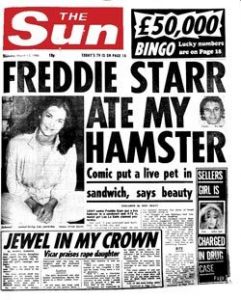Not all headlines are created equal. Newspaper editors have known this for years. Now, with the internet and social media, the art of headline writing is no longer the province of a few clever sub-editors, it’s a skill individuals, brands, writers, freelancers, bloggers — practically everyone — is learning.
It’s also no longer just an art. Writing headlines that win is now a science, too.
Writing good headlines used to be about intuition: Take the most important or outrageous factoid and turn it, skilfully, into a headline that catches the eye, sparks curiosity, and fits into the space available. Now it’s every bit as much about making sure Google and other search engines clearly understand what your article is about, so you come up on the first page of search results.
But let’s start with the art.
Good headlines make an impact.
Newspapers really developed the art of writing headlines. They were needed to sell both the newspaper itself and then the stories within them.
To do that, they need to make an impact. Firstly, they have to be easy to read: They have to be short, punchy, have a logical sentence structure, use proper punctuation and flow correctly. Secondly, they are written in the present tense, to add a sense of immediacy. But most importantly, they need to tease the reader, to get make them curious enough to read on. Shock, controversy and humour are all common ways to draw readers in.

This headline from Britain’s The Sun is so famous, it’s entered popular culture and is often quoted. Credit: The Sun.
Most headlines are more tame than the one above.
There was a great article a few years ago that looked at the old newspaper headline writers’ craft and intuition, if you want to read more. But these days, in the digital world, using intuition isn’t enough. These days, if you want people to find your content online, you need science.
How to write a good headline for online content
Whether you’re a reporter working online or a professional copywriting service, it’s important to understand that headlines for content published on the internet need to be somewhat more literal.
You can still be creative, but Google and other search engines, when they’re crawling the internet and cataloguing your site and all your new content, put a lot of weight on what’s in the headline and any sub-headings. It makes sense, right? That’s where you should find out what an article is about.
But it does mean the death of a certain level of creativity — at least if you want your content to rank well on Google. Magazine-style articles, for example, are often next to useless online. You can’t have a headline like “Symphony in Concrete”, for example, on an article about Brutalist architecture. While it works great in a magazine, Google will have no idea what you mean.
You’re far better off using a headline like “Here’s why people find Brutalist architecture beautiful”, or “10 beautiful Brutalist buildings made from concrete”. Why? Because Google will understand what the article is about. So when someone enters a search like “Why do some people think Brutalist buildings are beautiful?” — up you come!
Test your headlines using online tools
The science doesn’t end there. There are all sorts of online tools you can use to improve your headlines, to refine them and give them as good a chance as possible at succeeding.
The Advanced Marketing Institute has a Headline Analyser, which is free to use. It can help you find the strongest possible headline, according to its algorithm, based on the industry or field you’re writing about. It’ll tell you how strongly the headline will affect the reader intellectually, emotionally and spiritually (which really just means on a very deep emotional level). It’s a good idea to use a headline analysis tool every single time you write a headline.
Little tricks of the trade for copywriting and content marketing
Here are a few little things to remember, that can make your headlines more effective:
- Google will only show 55 to 60 characters of your headline, so anything more than that will get cut off in search results.
- Test your headlines, see what works, and do more of the same. It’s possible. Google Analytics allows you to put up to six different headlines on the same article (each reader only sees one headline) using their Content Experiments
- Avoid clickbait headlines. Headlines that over-promise and under-deliver only damage your brand. What’s the point of getting extra clicks on one article, just to have that reader leave disappointed, or angry, and never return?
You can still be creative in your headlines
Just because there’s a lot of science to writing a good online headline, doesn’t mean there’s not still an art to it. People are not machines. Algorithms may help us find headlines, but human curiosity is still what makes us pick up a story and read it. So if you have a really great headline — if Freddie Starr really did eat your hamster — why not use it? Put your keywords in your subheadings and in the copy instead.
If you want to work with a content marketing agency that understands all the tricks of the copywriting trade, but won’t compromise on quality (or, to be clear, the lives of hamsters), get in touch with Lush Digital Media.
Like what you’ve read? Sign up to the Lush newsletter for fortnightly advice to help you market your business better, tips from our video production gurus, and a podcast or two from our favourite podcasting team, Brand Newsroom. In the meantime, you might enjoy these:
Is Content Marketing The New SEO?
BNR#1: Headlines that over-promise and under-deliver









